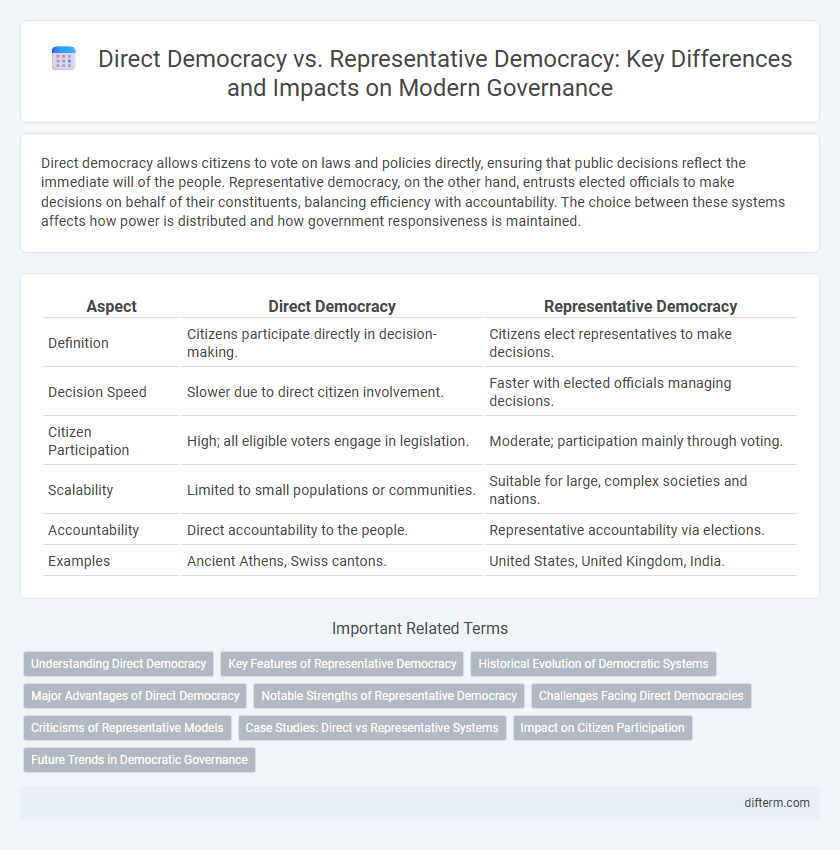Direct democracy allows citizens to vote on laws and policies directly, ensuring that public decisions reflect the immediate will of the people. Representative democracy, on the other hand, entrusts elected officials to make decisions on behalf of their constituents, balancing efficiency with accountability. The choice between these systems affects how power is distributed and how government responsiveness is maintained.
Table of Comparison
| Aspect | Direct Democracy | Representative Democracy |
|---|---|---|
| Definition | Citizens participate directly in decision-making. | Citizens elect representatives to make decisions. |
| Decision Speed | Slower due to direct citizen involvement. | Faster with elected officials managing decisions. |
| Citizen Participation | High; all eligible voters engage in legislation. | Moderate; participation mainly through voting. |
| Scalability | Limited to small populations or communities. | Suitable for large, complex societies and nations. |
| Accountability | Direct accountability to the people. | Representative accountability via elections. |
| Examples | Ancient Athens, Swiss cantons. | United States, United Kingdom, India. |
Understanding Direct Democracy
Direct democracy empowers citizens to participate directly in decision-making processes, enabling them to propose, debate, and vote on laws and policies without intermediary representatives. This system increases political engagement and accountability by giving individuals a direct voice in governance, often through tools such as referendums and initiatives. Understanding direct democracy requires analyzing its advantages in enhancing citizen participation and challenges in scalability for larger populations.
Key Features of Representative Democracy
Representative democracy features elected officials who act on behalf of citizens, making decisions through legislative processes. It emphasizes accountability through regular elections, political pluralism, and institutional checks and balances that prevent the concentration of power. This system facilitates governance in large, diverse populations where direct citizen participation in every decision is impractical.
Historical Evolution of Democratic Systems
The historical evolution of democratic systems reveals a transition from early forms of direct democracy, such as the Athenian Assembly where citizens voted firsthand on laws, to the development of representative democracy, exemplified by the Roman Republic's elected Senate. The rise of nation-states in the 17th and 18th centuries accelerated this shift, as larger populations required elected representatives to make governance practical. Modern democratic governments predominantly operate as representative democracies, balancing citizen participation with efficient, scalable decision-making structures.
Major Advantages of Direct Democracy
Direct democracy allows citizens to vote directly on laws and policies, ensuring a higher level of public participation and accountability. This system reduces the risk of misrepresentation and enhances transparency by giving people direct control over decision-making processes. Increased civic engagement promotes more informed and active citizenry, contributing to stronger community bonds and trust in government.
Notable Strengths of Representative Democracy
Representative democracy excels in managing complex societies by delegating decision-making to elected officials, ensuring efficient governance and policy expertise. It protects minority rights through structured institutions and balances diverse interests better than direct democracy. This system facilitates stability by preventing the volatility often seen in mass voting on every issue.
Challenges Facing Direct Democracies
Direct democracies face significant challenges such as scalability issues, where large populations struggle with frequent voting on complex policies, leading to voter fatigue and low participation rates. The risk of misinformation is heightened due to the reliance on widespread public knowledge and debate, making informed decision-making difficult. Additionally, direct democracy can be vulnerable to majority tyranny, potentially undermining minority rights without the checks provided by representative institutions.
Criticisms of Representative Models
Representative democracy faces criticism for potential disconnect between elected officials and the electorate, often leading to misaligned policy priorities. Critics argue that elected representatives may be influenced by special interest groups, reducing accountability and transparency in decision-making processes. Furthermore, slow legislative procedures and limited citizen participation can weaken democratic responsiveness and public trust.
Case Studies: Direct vs Representative Systems
Switzerland exemplifies direct democracy through its frequent use of referendums, allowing citizens to influence policy decisions directly, which enhances political engagement and policy responsiveness. In contrast, the United States employs a representative democracy where elected officials make decisions on behalf of citizens, promoting stability and efficient governance in a large, diverse population. Case studies comparing these systems highlight that direct democracy fosters higher public participation but can slow decision-making, whereas representative democracy balances citizen input with administrative practicality.
Impact on Citizen Participation
Direct democracy significantly increases citizen participation by allowing individuals to vote on policies and laws directly, fostering greater political engagement and accountability. Representative democracy relies on elected officials to make decisions, which can streamline governance but may distance citizens from the policymaking process and reduce active involvement. Countries with mechanisms for direct citizen input, such as referendums, often experience higher levels of political awareness and civic responsibility.
Future Trends in Democratic Governance
Emerging technologies such as blockchain and AI are poised to enhance direct democracy by enabling secure, real-time voting and increasing citizen participation in decision-making processes. Representative democracy is likely to evolve through hybrid models that integrate digital platforms, allowing elected officials to better reflect constituent preferences and respond swiftly to public needs. Future democratic governance trends emphasize transparency, inclusivity, and technological innovation to strengthen democratic legitimacy and resilience.
Direct Democracy vs Representative Democracy Infographic

 difterm.com
difterm.com